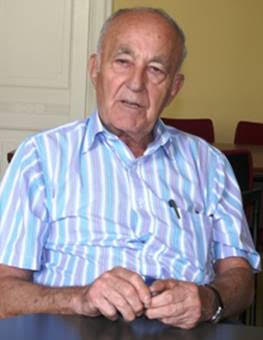
THE VOICE OF INTERNATIONAL LITHUANIA
|
VilNews has its own Google archive! Type a word in the above search box to find any article.
You can also follow us on Facebook. We have two different pages. Click to open and join.
|
Archive for January, 2013
New Lithuanian coins, of 1939-design, were bravely planned already in 1990
- Posted by - (0) Comment
|
Dear readers,
|
|
Message from Frank Passic, Albion, Michigan, USA.
Labas Aage,
Enjoying your rembrances of 22 years ago. During that period I was promoting Lithuania in the American numismatic press. A decade earlier, a main U.S. coin catalog publisher, Krause Publications, had dropped the individual listings of Lithuania's pre-WWII independent coinage under the "L's" and put them under the USSR listing under its new geography policy. After we collectors over here protested, they wouldn't budge, and instead said that when Lithuania became independent again they would then list Lithuanian coins under the "L's," but that Lithuania was part of the USSR and that that's how the coins would be listed in their catalogs. To my glee, I was able to write them a letter during this period informing them that Lithuania was again independent and that they should list Lithuanian coins under the "L's" again along with the other countries of the world in their Standard Catalog of World Coins. They did just that and Lithuanian coins are listed under the "L's", not USSR or "Baltic."
It was an exciting time for me to be writing about Lithuanian numismatics as the numismatic events unfolded and to share them with the American numismatic community. Attached is one of my articles that appeared in the major coin newspaper COIN WORLD of Sidney, OH, November 16, 1992.
Keep up the good work,
Frank Passic, Albion, Michigan, USA.
Frank Passic article from April 1990


Frank Passic article from November 1992

Read also:
Lithuanian camps in postwar Germany issued their own money!
https://vilnews.com/?p=12074
Vagnorkės – Talonas 20 year anniversary
https://vilnews.com/?p=8458
First and second round of Lithuanian Litas
https://vilnews.com/?p=9066
- Bookmark :
- Digg
- del.icio.us
- Stumbleupon
- Redit it
- Posted by - (0) Comment
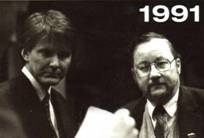
In January 1991 I crossed the barricades to visit President Vytautas Landsbergis in his Lithuanian Parliament office, while the Soviet troops and tanks continued to surround the building.
Visit to the Lithuanian Parliament (Seimas)
22 years later
This year I marked 13 January in the Lithuanian Parliament Building, 22 years after I in 1991 stood here along with Professor Landsbergis and looked out the window at the bonfires, barricades and the huge crowd of unarmed people who had gathered to protect their president and the country's future as a free nation.
I came here today with a group of young Lithuanians, most of them so young that they do not have their own memories of what happened here 22 years ago. Yet the memories of the sad events in January 1991 are very much alive and present for them. They want to remember that freedom and independence is not something you can take for granted, and they want to pursue a political career. They are Lithuania's future politicians. They are the future of young, well-educated, smart leaders that this country a few years ago could only dream about.
I walked around with them in the Parliament this 13th January. I saw their interests, and their pride in belonging to a great nation like this.
Read more...
__________________________
Nice to hear that there is hope for Lithuania

Kostas Cerskus Nice to hear that you Aage find that there is still hope for Lithuania!
__________________________
Encourage children to love their country so they will have respect someday as a citizen

Irene Simanavicius Everyone has a special affinity for the place they call home. Encourage children to love their country so they will have respect someday as a citizen. This is the best way to set a positive example. As children grow older, explain to them why you feel they should hold their country in high regard. ~:)
__________________________
I think we are facing a crossroads which bodes well for Lithuania!

Aage Myhre Kostas Cerskus, I have for some time now seen that young business people here are in full swing building up more professional structures and attitudes. That I now see the same happen among young politicians is very gratifying. Both of these groups feel to some extent that our new government is a step backwards, back to the "nomenclature times", but their young, Western-type way of thinking is certainly very encouraging and I think we are facing a crossroads which bodes well for Lithuania!
__________________________
You do not have to agree with every event and decision made in your country's history to love your country

Irene Simanavicius You certainly do not have to agree with every event and decision made in your country's history to love your country. Consider how the country recovered from mistakes, as well as its ideology as described in some guiding document (such as a constitution). Although such principles are not absolute, reflect on whether these precepts are conducive to a government you think would act with its citizens -- and humanity's -- best interests at heart.
__________________________
It appears that the young people are ready to take matters into their own hands, no longer waiting for the older politicians and leaders to show the way

Aage Myhre Irene Simanavicius, it is precisely such attitudes I now see more and more of among young Lithuanians. And this time, it appears that they are ready to take matters into their own hands, no longer waiting for the older politicians and leaders to show the way. It almost feels as if the spirit of January 1991 is back, now in a structured, pragmatic and professional manner.
__________________________
What you are reporting is excellent news

Irene Simanavicius ~Aage, what you are reporting is excellent news. Lithuanians from all over the world were actively involved in the events that transpired 22 years ago. We petitioned, we marched, we sent money for support and God knows we prayed hard!!!I just hope the young upcoming politicians remember:
What are some of the great things people have done and how they showed their love of their country? What are some of the things people have done with good intentions but poor results? Learned from their country's history -- both the good times and the bad times?
Now, they just have to learn to not be prejudiced or biased. Every country, religion, or racial group has its own beliefs. Like them you have your own so respect yours and respect them for theirs. As mentioned earlier… continually strive for a better country for all!
- Bookmark :
- Digg
- del.icio.us
- Stumbleupon
- Redit it
- Posted by - (0) Comment

Chevron set to win Lithuanian shale gas license
U.S. energy giant Chevron is poised to win a license for shale gas exploration in Lithuania, officials in the Baltic state announced Tuesday.
The license is for a field in western Lithuania, an area near the Baltic Sea where several small firms extract a tiny amount of crude oil. Last year Chevron bought a 50 percent stake in one of these firms, LL Investicijos, which owns a license to a neighboring field. Chevron officials have said they hoped to begin exploration work this year.
For Lithuania, shale gas – a form of natural gas trapped underground in porous rock and difficult to extract – represents a rare opportunity to decrease its energy dependency on Russia, which currently supplies all of the Baltic state's gas.
Read more…
- Bookmark :
- Digg
- del.icio.us
- Stumbleupon
- Redit it
- Posted by - (0) Comment

Fortum plans to build 3rd power plant in Lithuania
Lithuania's Fortum Heat Lietuva, controlled by Finnish energy concern Fortum, plans to build a combined heat and power plant (CHPP) for 500-700 million litai (around 145-200 million euro) in Vilnius.
"Today we officially announced in print that we are starting to develop this project. The power plant should be in the industrial district," Fortum Heat Lietuva chief Vitalijus Zuta told BNS.
Fortum Heat Lietuva is considering building a CHPP with heat capacity between 60 and 150 megawatts and electricity capacity between 30 and 50 MW. The specific technical terms will be determined after research is performed, he said.
Read more…
- Bookmark :
- Digg
- del.icio.us
- Stumbleupon
- Redit it
- Posted by - (0) Comment

Visit to the Lithuanian
Parliament (Seimas)
22 years later
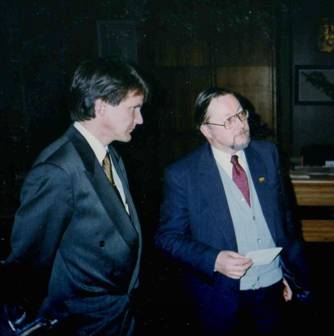
Lithuanian Foreign Ministry issued primitive passes for us,
and we managed to get through a long maze of controls,
barbed wire, concrete blocks and barricades that surrounded
the Lithuanian Parliament those January days in 1991. We got
the opportunity to visit this brave Parliament President,
Professor Vytautas Landsbergis, in his office. Here he
lived day and night for weeks while the Soviets
surrounded the building with troops and tanks.
Text and photos: Aage Myhre, Editor-in-Chief
aage.myhre@VilNews.com
This year I marked 13 January in the Lithuanian Parliament Building, 22 years after I in 1991 stood here in this building, along with Professor Landsbergis and looked out the window at the bonfires, barricades and the huge crowd of unarmed people who had gathered to protect their president and the country's future as a free nation.
I came here today with a group of young Lithuanians, most of them so young that they do not have their own memories of what happened here 22 years ago. Yet the memories of the sad events in January 1991 are very much alive and present for them. They want to remember that freedom and independence is not something you can take for granted, and they want to pursue a political career. They are Lithuania's future politicians. They are the future of young, well-educated, smart leaders that this country a few years ago could only dream about.
I walked around with them in the Parliament this 13th January. I saw their interests, and their pride in belonging to a great nation like this.
I also saw large photographs on the walls, with Lithuania's parliamentary history of the interwar time and from the years after the Declaration of Independence 11 March 1990. The sadness I felt when I walked around in these corridors 22 years was gone, now I felt only joy, and optimism regarding the country's future and its political leaders for the years to soon come.
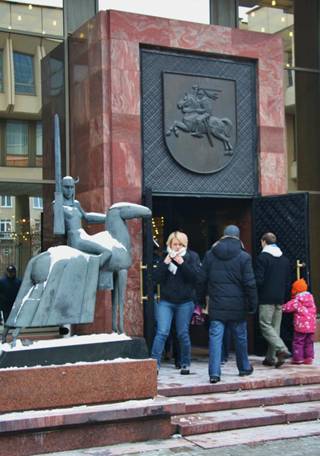
Entrance to the old part of the Parliament.
- Bookmark :
- Digg
- del.icio.us
- Stumbleupon
- Redit it
- Posted by - (1) Comment

Visit to the Lithuanian
Parliament (Seimas)
22 years later

Lithuanian Foreign Ministry issued primitive passes for us,
and we managed to get through a long maze of controls,
barbed wire, concrete blocks and barricades that surrounded
the Lithuanian Parliament those January days in 1991. We got
the opportunity to visit this brave Parliament President,
Professor Vytautas Landsbergis, in his office. Here he
lived day and night for weeks while the Soviets
surrounded the building with troops and tanks.
Text and photos: Aage Myhre, Editor-in-Chief
aage.myhre@VilNews.com
This year I marked 13 January in the Lithuanian Parliament Building, 22 years after I in 1991 stood here in this building, along with Professor Landsbergis and looked out the window at the bonfires, barricades and the huge crowd of unarmed people who had gathered to protect their president and the country's future as a free nation.
I came here today with a group of young Lithuanians, most of them so young that they do not have their own memories of what happened here 22 years ago. Yet the memories of the sad events in January 1991 are very much alive and present for them. They want to remember that freedom and independence is not something you can take for granted, and they want to pursue a political career. They are Lithuania's future politicians. They are the future of young, well-educated, smart leaders that this country a few years ago could only dream about.
I walked around with them in the Parliament this 13th January. I saw their interests, and their pride in belonging to a great nation like this.
I also saw large photographs on the walls, with Lithuania's parliamentary history of the interwar time and from the years after the Declaration of Independence 11 March 1990. The sadness I felt when I walked around in these corridors 22 years was gone, now I felt only joy, and optimism regarding the country's future and its political leaders for the years to soon come.

Entrance to the old part of the Parliament.
HISTORY OF TODAY’S PARLIAMENT BUILDING (SEIMAS)
The construction of the new Seimas building began in April 1976, on the site of a former stadium. By then, the Parliament was still directly depended on the Communist Party. The legal acts passed by the Supreme Council of the USSR was just a “decoration” of the Soviet order. Selected by sex, nationality, education, professions, membership in Communist or Young Communist organisations, the local trade union, so-called deputies used to convene two or three times per year and voted on the draft legal acts already submitted. Undoubtedly, this was an imitation of government, a spectacle. Indeed, the main lobby could remind one of a theatre.
Today’s democratic parliamentarian system got its first test on 11 March 1990, when the Lithuanian Supreme Soviet elected Vytautas Landsbergis president and formally declared Lithuania to be an independent nation. The Soviet President M. Gorbachev rejected the action, insisting that a separation had to be negotiated. In April same year he ordered an economic blockade of Lithuania, cutting off all oil supplies and reducing natural gas flow to one-quarter of the normal level. The blockade ended on 30 June after the Lithuanian Parliament voted to freeze the declaration of independence for 100 days in order to permit negotiations between Moscow and Estonia, Latvia, and Lithuania.
Then came 13 January 1991. That was the day when Soviet troops cracked down in Vilnius and the resulting bloodshed made headlines around the world. The action was apparently a bid to stop Lithuania’s independence drive in its tracks. But President Landsbergis and other political leaders wanted it all very differently, making the Parliament building a fortress for democracy and freedom those winter days, with thousands and thousands of unarmed Lithuanians surrounding the building and thereby stopping the Soviet troops from attacking.

ABOVE: The Lithuanian Parliament building as it looks today.
BELOW: Pictures on the Parliament walls, describing Lithuania’s parliamentarian events in 1990-1991.



ABOVE: Seimas, 11 March 1990, the day Lithuania re-claimed its independence.
BELOW: The same Parliament Hall today.


Today’s top modern Parliament Hall.
|
|
On the 11th of March 1990 the Lithuanian Supreme Council (today’s Parliament) decided to change the Soviet Coat of Arms hanging behind the chair of the parliament president (above), to Vytis, the symbol of genuine Lithuania (left). The coat of arms of Lithuania, consists of an armour-clad knight on horseback holding an olden sword and shield, also known as Vytis ("the Chaser"). The Lithuanian coat of arms is one of the oldest national coats of arms in Europe. It is one of very few containing symbolism adopted from ducal portrait seals rather than from coats of arms of dynasties, which is the case for most European countries.
|

ABOVE: Barricades and bonfires outside the Parliament in January 1991.
BELOW: This is what is left of the barricades today, covered by a modern glass structure.

BELOW: The Parliament’s entrance hall on 13 January 2013, filled with activities in memory of 13 January 1991.




80 year old Liuda Komarovskaja lost her health by defending the Vilnius TV Tower in the 13 January 1991 events.
She was beaten unconscious by the Soviet soldiers and rushed to the Santariškių Hospital in the outskirts of Vilnius. Here in conversation with Parliamentarian Petras Austrevicius in the Parliament last Sunday.

ABOVE: Antanas Terleckas, founder and leader of the Lithuanian Freedom League, was awarded the 2012 Freedom Prize at a solemn event at the Lithuanian Parliament on Sunday 13 January. Read more at http://www.15min.lt/en/article/culture-society/freedom-prize-awarded-to-lithuanian-freedom-league-leader-antanas-terleckas-528-296400
BELOW: A special exhibition about Antanas Terleckas’ life was presented in the Parliament during the13 January commemoration days.

BELOW: Pictures on the Parliament walls, from interwar sessions.


- Bookmark :
- Digg
- del.icio.us
- Stumbleupon
- Redit it
- Posted by - (1) Comment
The 2012 Parliament

| Political groups | Social Democratic (38) |
The Seimas of the Lithuanian Republic (Lithuanian: Lietuvos Respublikos Seimas), or simply the Seimas is the unicameral Lithuanian parliament. It has 141 members that are elected for a four-year term. About half of the members of this legislative body are elected in individual constituencies (71), and the other half (70) are elected by nationwide vote according to proportional representation. A party must receive at least 5%, and a multi-party union at least 7%, of the national vote to be represented in the Seimas.
Latest election
| Party | Proportional | Constituency | Total | +/– | ||
| Votes | % | Seats | ||||
| 251,610 | 18.37 | 15 | 23 | 38 |
| |
| 206,590 | 15.08 | 13 | 20 | 33 |
| |
| 271,520 | 19.82 | 17 | 12 | 29 |
| |
| 100,120 | 7.31 | 6 | 5 | 11 |
| |
| 117,476 | 8.57 | 7 | 3 | 10 |
| |
| 79,840 | 5.83 | 5 | 3 | 8 |
| |
| 109,448 | 7.99 | 7 | – | 7 | New | |
| 53,141 | 3.88 | – | 1 | 1 |
| |
| 28,263 | 2.06 | – | – | – |
| |
| 24,129 | 1.76 | – | – | – | New | |
| 16,515 | 1.21 | – | – | – |
| |
| 16,494 | 1.20 | – | – | – | New | |
| For Lithuania in Lithuania | 12,854 | 0.94 | – | – | – | New |
| 8,632 | 0.63 | – | – | – |
| |
| Democratic Labour and Unity Party | 4,383 | 0.32 | – | – | – | New |
| Emigrants Party | 4,015 | 0.29 | – | – | – | New |
| Republican Party | 3,661 | 0.27 | – | – | – | New |
| Lithuanian People's Party | 3,399 | 0.25 | – | – | – | New |
| Independents | – | – | – | 3 | 3 |
|
| Invalid/blank votes | 57,924 | – | – | – | – | – |
| Total | 1,370,014 | 100 | 70 | 70 (1 to go) | 140 | – |
| Registered voters/turnout | 2,588,418 | 52.93 | – | – | – | – |
| Source: VRK | ||||||
- Bookmark :
- Digg
- del.icio.us
- Stumbleupon
- Redit it
- Posted by - (0) Comment
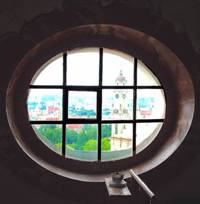
Vilnius through an Italian camera lens
Photos: Erica from Bologna, Northern Italy
My name is Erica, I am 30 and I write from Italy. In 2009 I spent the spring time in Lithuania. I fell in love with this country, and here is why.
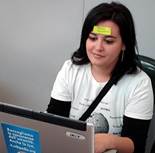
__________________________
A very heartwarming story. Thank you Erica.
Bernard Terway
__________________________
Erica: Really enjoyed reading your story. It is very nice to hear a non-Lithuanian praising our country. Hope you will return and also encourage your friends to do so as well.
Vytas Jonas
__________________________
Thank You (Aciu) for the tour via your words and eyes!!! You've captured much of what I too felt on my one and only trip (so far) to Lietuva. Your memories will last a lifetime. Have you plans to return? To rewalk your route from 2009?
Great job, and THANK YOU for sharing! Great photos too:)
Jenifer
__________________________
Thanks for your feedback! Actually I really, really hope to go back soon. I am just not sure when, watching some pictures makes me think that fall would be a great season (not too hot, not too cold); but springtime is when most of the events happen. Then, I also love snow, so... I can't decide! Should I rewalk the routes I know so well, or should I discover new places? Should I come alone or take someone with me? Also, lately I am quite afraid to find out that this nostalgic wait will make me feel disappointed once I'm there...
Erica
- Bookmark :
- Digg
- del.icio.us
- Stumbleupon
- Redit it
- Posted by - (0) Comment
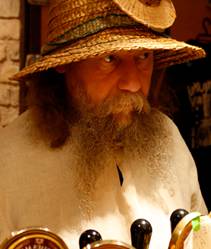
New York Times:
Lithuania on the top 46 list among places to visit in 2013!
"The Old World is webbed with well-traveled beer trails in places like Belgium, Germany and the Czech Republic. But in the past few years, rumors have swirled about an overlooked historic beer trail in Lithuania. Centered around the town of Birzai, a town in the country’s north, some 50 to 70 farmhouse breweries are producing earthy, unusual ales, often employing techniques not seen elsewhere, and fermented with types of brewing yeast that — as the Canadian beer writer Martin Thibault has discovered — appear to have different DNA from all other known strains. To get a taste of what the Lithuanian beer trail offers, sample the wares at specialty beer bars like Bambalyne, Alaus Namai and Snekutis in the capital, Vilnius. After that, the truly intrepid can seek out countryside breweries." — Evan Rail
Read more…
- Bookmark :
- Digg
- del.icio.us
- Stumbleupon
- Redit it
- Posted by - (0) Comment
 The bonfires and
The bonfires and
barricades that
saved Lithuania
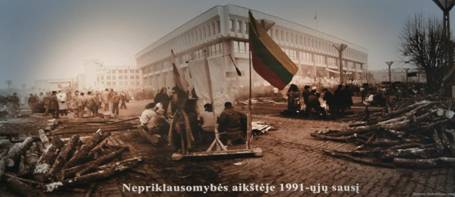

In January 1991, the Lithuanian Parliament was for weeks surrounded by hordes of people, bonfires, concrete blocks and vehicles that the Lithuanian people had brought there to protect their leader and their elected representatives against the Soviet atrocities against innocent
people. Today, exactly 22 years later, the Parliament is
surrounded by peaceful, quiet winter streets.
Top photo: Zenono Nekrošiaus
Text and photos: Aage Myhre, Editor-in-Chief
aage.myhre@VilNews.com
It was not bonfires, concrete blocks, steel beams, barbed wire or tractors which in themselves rescued Lithuania in January 1991. But it was these simple remedies, not weapons, that came to represent the peaceful resistance Lithuanians showed towards their powerful opponent from the east.
I'll never forget the sight of the flames and the large crowd that met me the day I was walking down the Gedimino prospekto towards the Parliament an icy winter day in January 1991. I read a combination of hope and despair in the faces, but first of all I saw determination. This time we will not surrender! The Soviet Union shall not again be allowed to trample us down under its iron heel!
The tactics succeeded. The Lithuanian people united as never before, or since, and the assailants had to withdraw in favour of a free and democratic Lithuania. Some of the symbols of this defining moment in our country's history can still be seen outside the Parliament.
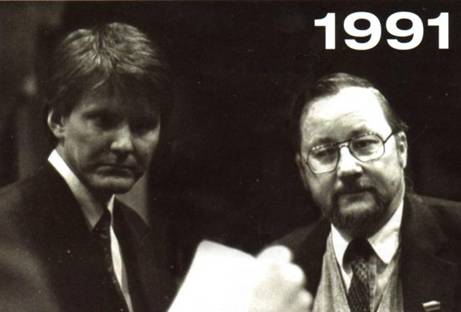
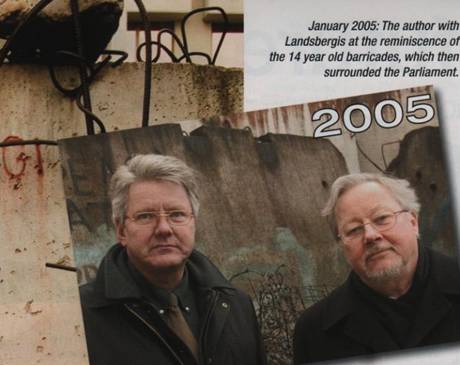
In January 1991 I crossed the barricades to visit President Vytautas Landsbergis in his Lithuanian Parliament office, while the Soviet troops and tanks continued to surround the building. 14 years later we visited together what was left of the concrete barricades from that time. These are now protected by a glass structure.

1991
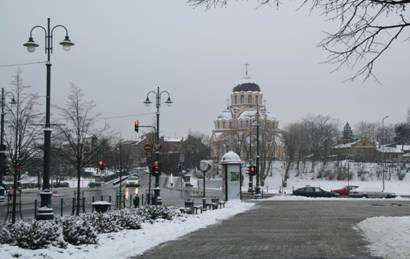
2013
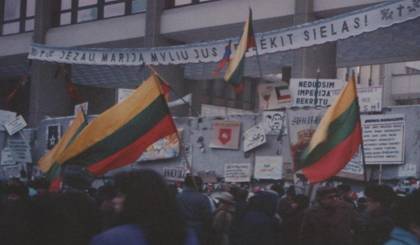
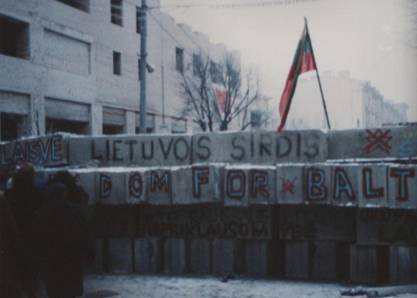
1991


2013
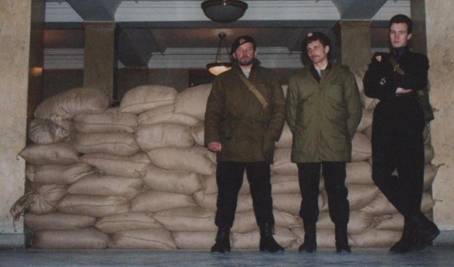
It was very touching to see how the Balts acted to keep their newfound freedom and protect their home country during the very difficult January days of 1991. Here, at the entrance to the Lithuanian Foreign Ministry, the young men have put on homemade clothes that are meant to look like uniforms. They carry rifles and other weapons they have found in their homes. Sand bags have an important symbolic effect. Brave guys!
Photo: Aage Myhre, 18 January 1991.
- Bookmark :
- Digg
- del.icio.us
- Stumbleupon
- Redit it
- Posted by - (0) Comment
 The bonfires and
The bonfires and barricades that
saved Lithuania


In
January 1991, the Lithuanian Parliament was for weeks surrounded by hordes of people,
bonfires, concrete blocks and vehicles that the Lithuanian people had brought
there to protect their leader and their elected representatives against the
Soviet atrocities against innocent people. Today, exactly 22 years later,
the
Parliament is surrounded by peaceful, quiet winter streets.
Top
photo: Zenono Nekrošiaus
Text
and photos: Aage Myhre, Editor-in-Chief
aage.myhre@VilNews.com
It was not bonfires, concrete blocks, steel beams, barbed wire or tractors which in themselves rescued Lithuania in January 1991. But it was these simple remedies, not weapons, that came to represent the peaceful resistance Lithuanians showed towards their powerful opponent from the east.
I'll never forget the sight of the flames and the large crowd that met me the day I was walking down the Gedimino prospekto towards the Parliament an icy winter day in January 1991. I read a combination of hope and despair in the faces, but first of all I saw determination. This time we will not surrender! The Soviet Union shall not again be allowed to trample us down under its iron heel!
The tactics succeeded. The Lithuanian people united as never before, or since, and the assailants had to withdraw in favour of a free and democratic Lithuania. Some of the symbols of this defining moment in our country's history can still be seen outside the Parliament.


In
January 1991 I crossed the barricades to visit President Vytautas Landsbergis
in
his Lithuanian Parliament office, while the Soviet troops and tanks continued
to
surround the building. 14 years later we visited together what was left of the
concrete
barricades from that time. These are now protected by a glass structure.

1991


2013



1991




2013

It
was very touching to see how the Balts acted to keep their newfound freedom and
protect their home country during the very difficult January days of 1991. Here, at the entrance to the Lithuanian Foreign Ministry,
the young men have put on homemade clothes that are meant to look like
uniforms. They carry rifles and other
weapons they have found in their homes. Sand
bags have an important symbolic effect. Brave guys!
Photo:
Aage Myhre, 18 January 1991.
- Bookmark :
- Digg
- del.icio.us
- Stumbleupon
- Redit it
- Posted by - (0) Comment
By: Linas Johansonas LTnews.net
(Cleveland) Linas Muliolis was your average young Lithuanian born in the USA. The son of World War II refugees, Linas grew up in Cleveland's Lithuanian community. In January 1991, he was just a month away from turning 21 years old & was in Vilnius during the historic Jan. 13 events. Earlier this week, LTnews.net talked with Linas about his experiences 22 years ago.
HOW DID A YOUNG MAN FROM CLEVELAND END UP IN VILNIUS DURING A 'REVOLUTION'? "I went there (Lithuania) to live for a year, to study language at Vilnius University. Things were heating up and in the beginning of January, I went there (parliament building) and volunteered to be an interpreter. I worked in the information bureau with Rita Dapkute".
WERE YOU AT THE PARLIAMENT BUILDING ON JAN. 13? "Yes. I was there for four days with only two, four-hour breaks of sleep ..... Had my own gasmask issued to me". (it was 108 hours with 2 four-hour naps)
- Bookmark :
- Digg
- del.icio.us
- Stumbleupon
- Redit it
- Posted by - (0) Comment
How a Lithuanian from America
ended up in the middle of historic
Jan. 13 events in Vilnius

By: Linas Johansonas LTnews.net
(Cleveland) Linas Muliolis was your average young Lithuanian born in the USA. The son of World War II refugees, Linas grew up in Cleveland's Lithuanian community. In January 1991, he was just a month away from turning 21 years old & was in Vilnius during the historic Jan. 13 events. Earlier this week, LTnews.net talked with Linas about his experiences 22 years ago.
HOW DID A YOUNG MAN FROM CLEVELAND END UP IN VILNIUS DURING A 'REVOLUTION'? "I went there (Lithuania) to live for a year, to study language at Vilnius University. Things were heating up and in the beginning of January, I went there (parliament building) and volunteered to be an interpreter. I worked in the information bureau with Rita Dapkute".
WERE YOU AT THE PARLIAMENT BUILDING ON JAN. 13? "Yes. I was there for four days with only two, four-hour breaks of sleep ..... Had my own gasmask issued to me". (it was 108 hours with 2 four-hour naps)
WERE THERE ANY OTHER "VOLUNTEERS" FROM ABROAD THERE? "From America, I think Rita Dapkute, Darius Suziedelis & I were the only 3. There was a group from Moldova. There was about a half dozen of them, in case of attack, they were there mostly for moral support but it was nice to have them there... very well received".
SO THE MOLDOVANS WERE THERE TO DEFEND THE PARLIAMENT BUILDING? "Basically yes... I can't remember if they were armed... I think I only remember seeing guns once ..... on the main floor..."
DID YOU EVER WORRY ABOUT WHAT WOULD HAPPEN TO YOU IF THE SOVIETS TRIED TO OR DID TAKE OVER THE PARLIAMENT BUILDING? "No, not at all, why would I worry about that? (he answered jokingly). I made sure I kept my passport with me at all times, in case.. who knows if it would have helped, though. I always said the rest of my life would be anti-climactic".
WERE YOU EVER TOLD WHAT TO DO IF THE BUILDING WAS ATTACKED? WERE YOU GIVEN A GUN? "No - there were practically no guns to be seen, this was primarily a peaceful protest... I WAS issued a gasmask though, because there were rumours of attack by gas".
WAS THERE EVER A TIME YOU THOUGHT TO YOURSELF 'WHAT AM I DOING HERE? AM I GOING TO DIE'? Yes, the whole time!
WHAT WAS THE MOOD LIKE INSIDE THE PARLIAMENT BUILDING ON JAN. 13? "STRESS! Pretty much what you would expect, desperation, frustration with the rest of the world, stress, worry, fear... etc".
WHAT WAS THE FRUSTATION WITH THE REST OF THE WORLD?
About non action. I remember one newspaper cartoon, for example, a rear view of Landsbergis facing a window, you see from the back that he is holding a phone, the view out the window shows a new oil well spraying oil in the air.. He says "President Bush? Guess what!"
The world was focused on the first Iraqi war, but yet on Jan 13th, we still made the top headline
DID YOU EVER CROSS PATHS WITH VYTAUTAS LANDSBERGIS DURING THIS TIME? "Yes. I was in his office once or twice, I was called in to help translate one night.. but I didn't do a great job, though, I have to admit. Once you get technical in some subject, you know how hard it can get".
WHAT WAS LANDSBERGIS LIKE? "He was calm, focused, definitely calm and reserved".
WHEN DID THOSE OF YOU IN THE PARLIAMENT BUILDING HEAR ABOUT THE CIVILIAN DEATHS? We heard about the deaths as they were happening. I remember the death count rising. I was surprised how accurate the news reports were in the US and in the UK, everything was pretty accurate, sometimes the number of deaths was off, but considering how confusing the time was overall, the news articles I saw were close to reality.
DID YOU HAVE ANY CONTACT WITH YOUR FAMILY BACK IN CLEVELAND? Yes. After I took the photo of the Soviet tanks (posted below) I was on the phone with my mother at the time, "Mom, don't be scared, but there is a column of tanks going by" probably was not a good thing to say to my mom. She turned gray that year.
BEING AN AMERICAN-BORN LITHUANIAN, HOW WERE YOU TREATED BY THE NATIVE LITHUANIANS IN THE PARLIAMENT BUILDING? "People were grateful for me being there. I was generally well accepted By that time I had learned to look and act local, gotten rid of most of my American accent, though"
WAS THERE ANY SINGLE MOMENT THAT STANDS OUT FOR YOU? "The single most amazing thing I saw happened late at night, I believe it was on the night of January 12th, I may be wrong. Do you remember the photo of the lone Chinese man standing in front of a column of tanks at Tiananmen Square? The Parliament Building is right next to the river, and there was a bridge over it leading to the square where hundreds of thousands of people were protesting and guarding our fledgling government. That night, suddenly someone in the room called out, said there were reports of a column of tanks racing towards us.. Hearts pounding, we raced to the windows. I was on the fourth floor so had a great view. A long column of tanks came racing towards us. The most amazing thing I have ever seen in my entire life, was the mass of people simply rush in to block the way. Those tanks would EASILY have crushed hundreds of people in seconds if the continued through. I have never witnessed such bravery and selflessness in my entire life. Luckily, however, at the last seconds, those tanks and APC's slowed down and turned right, away from the Parliament Building ".
WHEN DID YOU FEEL EVERYTHING WAS GOING TO BE OK? "When most of the tanks left".
ANY FINAL THOUGHTS? "This was definitely one of the most memorable times of my life, something I will never forget! My whole life I had been taught that someday Lithuania will again be free, that we needed to keep the language and culture alive.. Then, when I was 20, turning 21 - It happened and I was a part of it!"

Cleveland Plain Dealer - Jan. 1991

Photo by Linas Muliolis taken from parliament building - Jan. 1991

Photo by Linas Muliolis taken from parliament buikding - Jan. 1991

Linas Muliolis - Cleveland, Ohio - 2012

Jenifer C. Dillis Simply heart-stopping...

Linas K Muliolis I have to add something to this, I don't know how I forgot.. You caught me during an extremely busy week for this interview and I did not get enough chance to rehash all of the events. The single most amazing thing I saw happened late at night, I bel...See More

Jean-Paul Le Clercq Go Linas Go! The Soviets had no idea what was waiting for them behind Parliament walls!

Sam Salerno I feel shameful that I've never heard of this. Makes me wonder what else is going on in the world today that I don't know about. You're an Awesome man Linus.

Jūra Liaukonytė Thank you LT news for this interesting interview.

Dana Baltutis Yeah...its an event I wont forget. I still have the videos that my close friend Monika, her mum and I smuggled out via the Australian embassy in Moscow a few weeks later.

Rita Kova Murnane I was there in August of 91...

Jurate Grigonis Dana Baltutis from Australia was also there.

Tony Geraci Wow!

Ruta Rusinas Tomas Zizys from Toronto was also there.

Mardell Ward awesome! that was really interesting.

Dana Baltutis We were standing outside the television station when the tanks came and the soldiers started to jump out of the tanks with their guns.. Ill never forget the rumble and confusion. A friend who I was with got shot in the leg. We had to crouch down and run from the gunfire. People were so brave that night and next morning going to the Parliament knowing what had happened the night before.

Mindaugas Petrauskas Another unsung hero.. The majority of Lithuanian people do not know anything about stories like this.

Giedrius Pavardenis Hey guys, you're all awesome

Roberta Zarnauskaite We can only admire the unity and bravery of people at that time!
I wish nation still has it in the blood!!
Peace to all!
- Bookmark :
- Digg
- del.icio.us
- Stumbleupon
- Redit it
- Posted by - (0) Comment
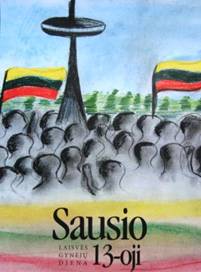
22 YEARS AGO
The infamous 1991 January events took place in Lithuania 11-13 January 1991, in the aftermath of the Act of the re-establishment of the State of Lithuania. As a result of Soviet military actions, 14 civilians were killed and more than 1000 injured.

Jon Platakis 22 years ago, Lithuanians paid the price for freedom. I wonder if Lithuanians are willing to pay the price for freedom today.

Aage Myhre Jon Platakis, I think they would. The difference from 1991 is that back then they had an outspoken leader and a clear vision. Unfortunately, these features have been in short supply in Lithuania since then ...

Bartłomiej Kolubiński Glory to the Brave People!

Jenifer C. Dillis ...I just cried...As an American Lit, I had NO IDEA what was happening in Jan 1991. I was in college, safely tucked away here in America. My roots are Lit, but without having had any contact with any relatives or friends back in those days, I only HEARD stories of a frequent visitor who smuggled Levis in. I'm ashamed now...I was clueless of the truth...and my heart bleeds for Lietuva's Freedom Fighters both old and new...

Boris Bakunas All of Eastern Europe was aflame with hope back then. Many of those hopes remain to be fulfilled.

Jenifer C. Dillis no longer tanks to take on face~to~face...Hope can never die. It may be dimmed, but still burns! Tell us, PLEASE, how to help build it back up, and move forward. "Lietuva, Lietuva, Lietuva," is still ringing in the ears of millions...
- Bookmark :
- Digg
- del.icio.us
- Stumbleupon
- Redit it
- Posted by - (0) Comment
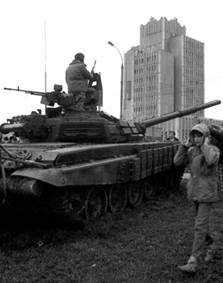
Soviet version of 1991 events in Vilnius survives to this day in Moscow
Twenty-two years ago today, as all independent investigations have confirmed, Soviet forces shot and killed 13 unarmed Lithuanian demonstrators at the Vilnius television tower, an event that galvanized the independence movement in that Baltic republic and triggered drives for independence from the USSR elsewhere.
But at the time of those events and shortly thereafter, pro-communist and pro-Soviet writers came up with an alternative explanation: they insisted that the Lithuanian Sajudis movement had organized the entire event as a provocation to the point of having its own operatives shoot and kill their fellow Lithuanians.
And some of those have even insisted that this conspiracy was part of a broader plot involving Vytautas Landsbergis who supposedly saw such a step as a necessary precondition to establishing a “fascist” and anti-Russian regime in Lithuania and even the United States which supposedly wanted a distraction as it moved to attack Iraq’s Saddam Hussein.
The most hyperbolic of these conspiracy theories have fallen as a result of their own internal inconsistencies – Landsbergis is no fascist and Washington’s Desert Storm campaign in fact limited its response to Moscow’s actions in Lithuania – but others have enough plausibility for some to discredit Lithuania’s drive to recover its de facto independence and its subsequent policies.
Such conspiracy theories about the Vilnius events of January 13, 1991, would be of limited interest were it not for two things. On the one hand, they continue to circulate among some writers in the Russian capital. And on the other, the thinking of Soviet leaders that stood behind them, if not the specific details, appear to be informing Moscow’s policy now.
On Friday, the portal of Moscow’s Strategic Culture Foundation featured a 1500-word article by Nikolay Malishevsky that repeats most of the claims against Lithuania, Sajudis, and Landsbergis by the conspiracy theorists and provides what he says is proof of all of them (www.fondsk.ru/news/2013/01/11/...
Read more…
- Bookmark :
- Digg
- del.icio.us
- Stumbleupon
- Redit it
- Posted by - (0) Comment
If there were those in the West who had not heard of Lithuania before, they almost certainly had by the end of the day
13 January 1991
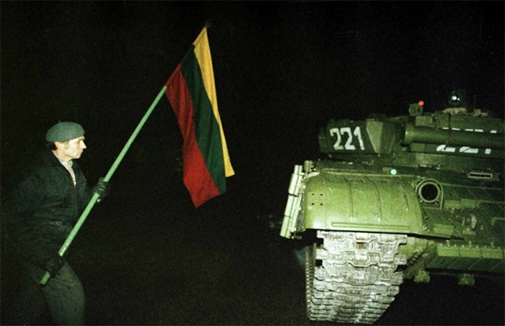
Heavy tanks were used by the Soviet forces when they attacked the Vilnius TV tower and the Parliament building on 13 January 1991. They were met by a wall of unarmed people who refused to allow the intruders to again take control of their homeland.
Text: Aage Myhre, editor-in-chief
aage.myhre@VilNews.com
"Lithuanians, do not resist, your government has betrayed you. Go home to your families and children."
This was the repeated announcement from the Soviet military vehicles with loudspeakers on the roofs, so-called sound trucks that rolled through the streets of Vilnius in January 1991. But fortunately for Lithuania and the United Europe that we now take more or less for granted, there was a music professor and a complete small nation that wanted it all differently.
Had it not been for this peaceful struggle of recovered freedom against an invasion and occupation, the people of the Baltic States never wanted or agreed to, the map of Europe would most likely have looked quite different today.
If there were those in the West who had not heard of Lithuania before, they almost certainly had by the end of the day 13 January 1991. It was the day that Soviet troops struck in Vilnius. The bloodshed that followed made headlines around the world. The attack was apparently an attempt to stop the Lithuanian independence movement in its very beginning.
When the smoke of the Soviet weapons ceased, more than a dozen people had been killed, hundreds injured. Soviet’s attack, and especially the killings at the TV tower, brought not only fame and sympathy for Lithuania from around the world, it was also a defining moment for the Lithuanians themselves.
The bloodshed meant that a point of no return had been crossed. If there was someone who until now had believed that a peaceful settlement with Moscow was possible, it was now clear to everyone that such a thing was unthinkable.
VIDEO FROM 13 JANUARY 1991
The 1991 January events took place in Lithuania between January 11 and 13, in the aftermath of the Act of the re-establishment of the State of Lithuania. As a result of Soviet military actions, 14 civilians were killed and more than 1000 injured. The events were centered in Vilnius, along with related actions in the cities of Alytus, Šiauliai, Varėna, and Kaunas.
- Bookmark :
- Digg
- del.icio.us
- Stumbleupon
- Redit it
VilNews e-magazine is published in Vilnius, Lithuania. Editor-in-Chief: Mr. Aage Myhre. Inquires to the editors: editor@VilNews.com.
Code of Ethics: See Section 2 – about VilNews. VilNews is not responsible for content on external links/web pages.
HOW TO ADVERTISE IN VILNEWS.
All content is copyrighted © 2011. UAB ‘VilNews’.

 Click on the buttons to open and read each of VilNews' 18 sub-sections
Click on the buttons to open and read each of VilNews' 18 sub-sections 










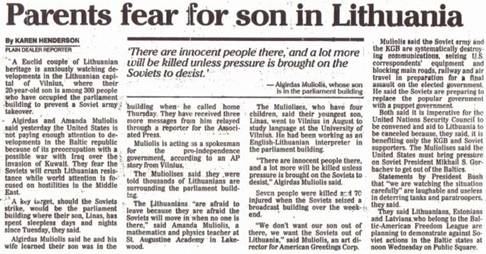
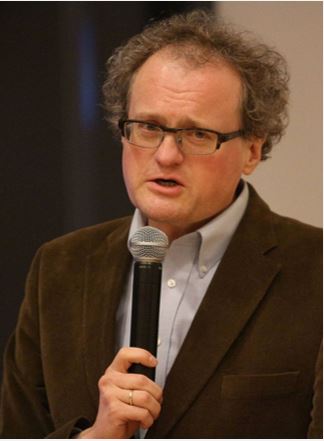
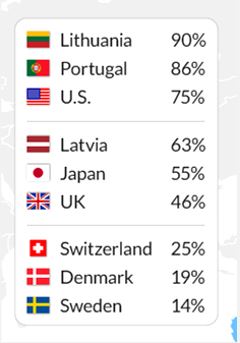
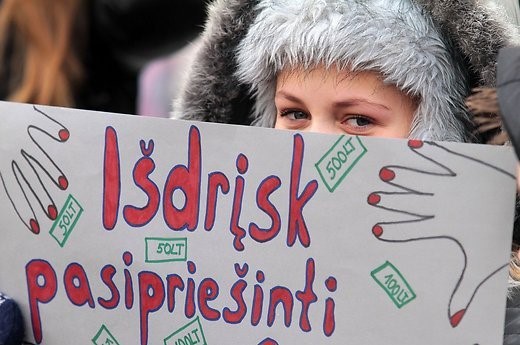


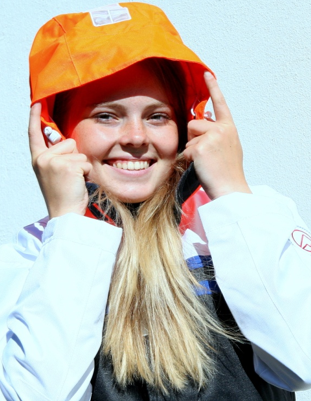
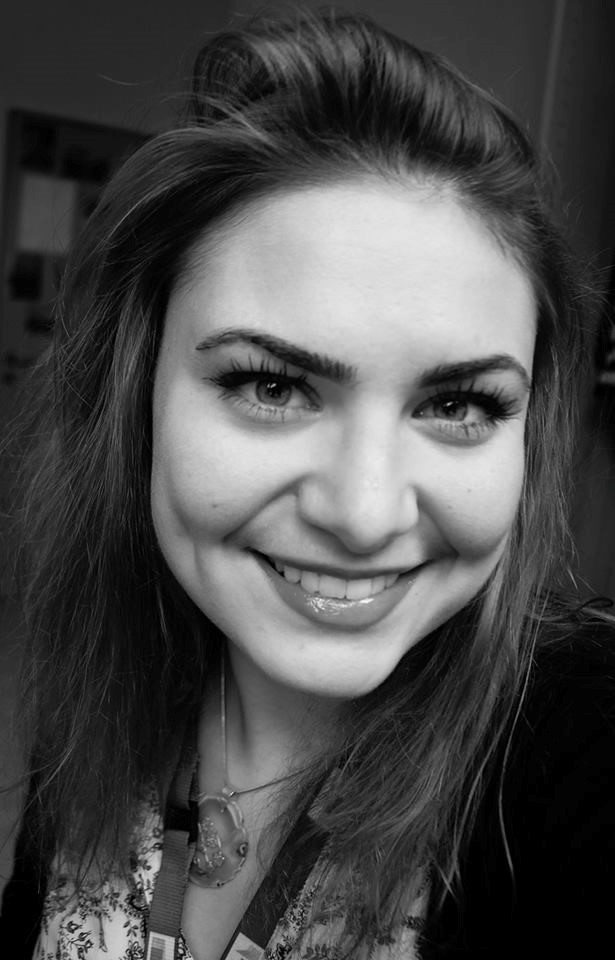
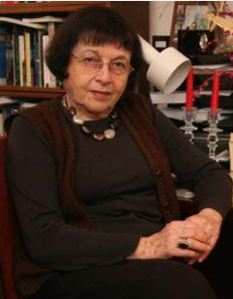
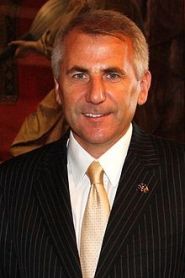
.jpg)
